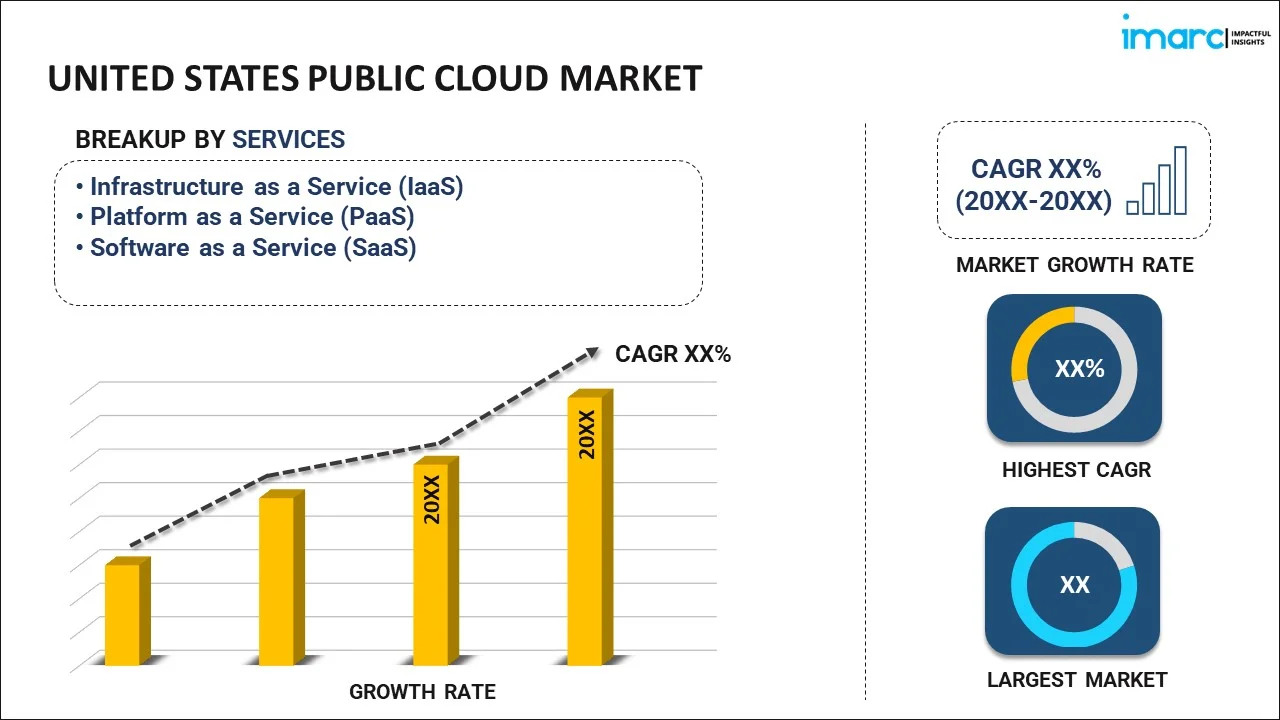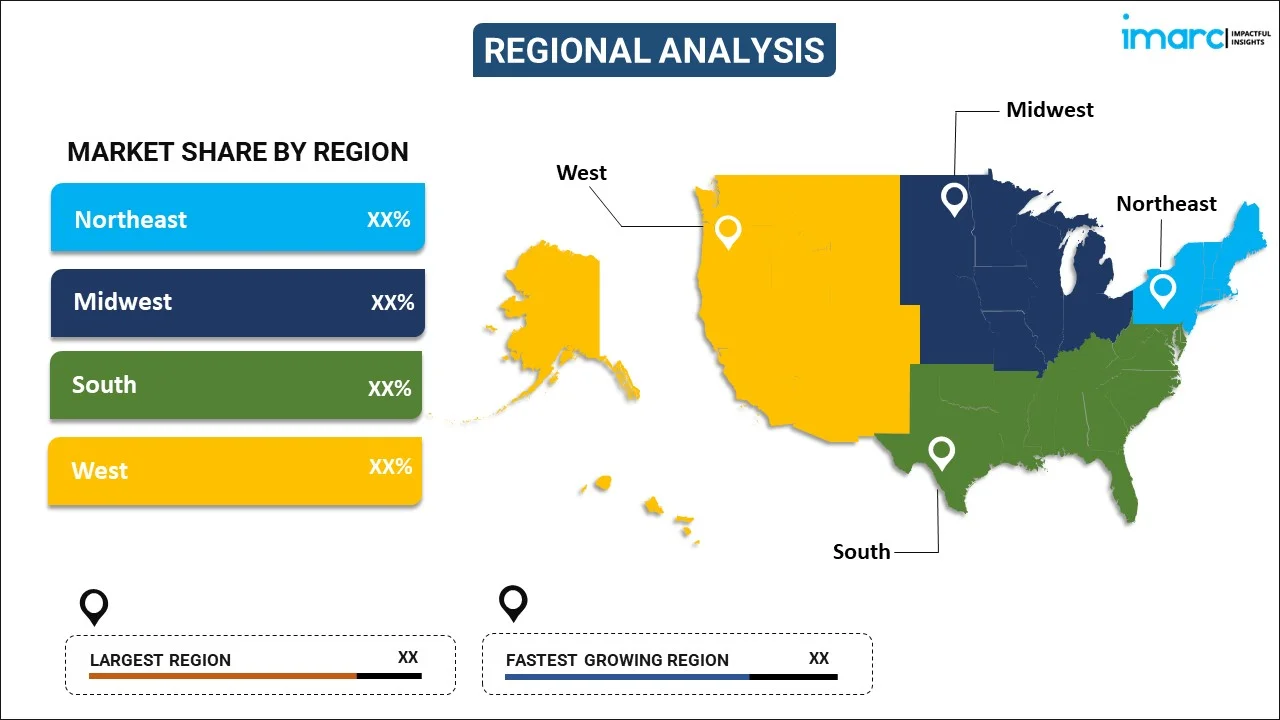
United States Public Cloud Market Report by Service (Infrastructure as a Service (IaaS), Platform as a Service (PaaS), Software as a Service (SaaS)), Enterprise Size (Large Enterprises, Small and Medium-sized Enterprises), End Use (BFSI, IT and Telecom, Retail and Consumer Goods, Manufacturing, Energy and Utilities, Healthcare, Media and Entertainment, Government and Public Sector, and Others), and Region 2025-2033
Market Overview:
United States public cloud market size is projected to exhibit a growth rate (CAGR) of 8.74% during 2025-2033. The growing need to modernize information technology (IT) infrastructure, applications, and processes, rising need to automate software development and testing, and increasing preferences for energy-efficient and eco-friendly solutions represent some of the key factors driving the market.
|
Report Attribute
|
Key Statistics
|
|---|---|
|
Base Year
|
2024 |
|
Forecast Years
|
2025-2033
|
|
Historical Years
|
2019-2024
|
| Market Growth Rate (2025-2033) | 8.74% |
A public cloud is a cloud computing service provided by third-party vendors over the internet. It comprises infrastructure as a service (IaaS), platform as a service (PaaS), and software as a service (SaaS). It operates on a pay-as-you-go or subscription-based pricing model that eliminates the need for organizations to purchase and maintain costly on-premises hardware and software. It can securely store and back up data in the cloud, ensuring data availability and disaster recovery preparedness. It facilitates remote work and collaboration by offering a wide array of cloud-based productivity and communication tools. It enables companies to access and utilize computing resources, software applications, and storage capacity without the need for on-premises infrastructure. It provides scalability, cost-efficiency, and accessibility and is suitable for organizations seeking to streamline operations. It allows users to easily adjust their resource allocation based on changing needs, which is particularly valuable for companies with fluctuating workloads. It enables organizations to handle workload variations efficiently without the need for significant capital investments. It assists in providing the computational power and storage capacity required for processing and analyzing vast amounts of data. As it aids in handling infrastructure maintenance, software updates, and security patches, the demand for public cloud is rising in the United States.
United States Public Cloud Market Trends:
At present, the escalating demand for public cloud to reduce information technology (IT) infrastructure costs and optimize operational expenses represents one of the major factors influencing the market positively in the United States. Additionally, the increasing adoption of public cloud, as it handles vast amounts of data and supports data-driven decision-making, is impelling the growth of the market in the country. Apart from this, there is a rise in the demand for scalable, affordable, and flexible solutions in organizations. This, coupled with the growing employment of public cloud, as it offers compliance certifications and tools to help companies meet regulatory requirements, is offering a positive market outlook in the country. Moreover, the increasing usage of public cloud services to modernize the IT infrastructure, applications, and processes of a company is bolstering the growth of the market. In line with this, the introduction of new technologies and services, such as artificial intelligence (AI), machine learning (ML), and Internet of Things (IoT) tools, enable companies to stay competitive and adopt advanced solutions without the need for extensive in-house development, which is strengthening the market growth in the US. Furthermore, the rising utilization of public cloud, as it allows organizations to automate software development and testing, is providing lucrative growth opportunities to industry investors. In addition, the increasing adoption of public cloud, as it is more energy-efficient and eco-friendly compared to traditional data centers, is contributing to the market growth in the country.
United States Public Cloud Market Segmentation:
IMARC Group provides an analysis of the key trends in each segment of the market, along with forecasts at the country level for 2025-2033. Our report has categorized the market based on service, enterprise size, and end use.
Service Insights:

- Infrastructure as a Service (IaaS)
- Platform as a Service (PaaS)
- Software as a Service (SaaS)
The report has provided a detailed breakup and analysis of the market based on the service. This includes infrastructure as a service (IaaS), platform as a service (PaaS), and software as a service (SaaS).
Enterprise Size Insights:
- Large Enterprises
- Small and Medium-sized Enterprises
A detailed breakup and analysis of the market based on the enterprise size have also been provided in the report. This includes large enterprises and small and medium-sized enterprises.
End Use Insights:
- BFSI
- IT and Telecom
- Retail and Consumer Goods
- Manufacturing
- Energy and Utilities
- Healthcare
- Media and Entertainment
- Government and Public Sector
- Others
The report has provided a detailed breakup and analysis of the market based on the end use. This includes BFSI, IT and telecom, retail and consumer goods, manufacturing, energy and utilities, healthcare, media and entertainment, government and public sector, and others.
Regional Insights:

- Northeast
- Midwest
- South
- West
The report has also provided a comprehensive analysis of all the major regional markets, which include Northeast, Midwest, South, and West.
Competitive Landscape:
The market research report has also provided a comprehensive analysis of the competitive landscape. Competitive analysis such as market structure, key player positioning, top winning strategies, competitive dashboard, and company evaluation quadrant has been covered in the report. Also, detailed profiles of all major companies have been provided.
United States Public Cloud Market Report Coverage:
| Report Features | Details |
|---|---|
| Base Year of the Analysis | 2024 |
| Historical Period | 2019-2024 |
| Forecast Period | 2025-2033 |
| Units | Billion USD |
| Scope of the Report | Exploration of Historical and Forecast Trends, Industry Catalysts and Challenges, Segment-Wise Historical and Predictive Market Assessment:
|
| Services Covered | Infrastructure as a Service (IaaS), Platform as a Service (PaaS), Software as a Service (SaaS) |
| Enterprise Sizes Covered | Large Enterprises, Small and Medium-sized Enterprises |
| End Uses Covered | BFSI, IT and Telecom, Retail and Consumer Goods, Manufacturing, Energy and Utilities, Healthcare, Media and Entertainment, Government and Public Sector, Others |
| Regions Covered | Northeast, Midwest, South, West |
| Customization Scope | 10% Free Customization |
|
Post-Sale Analyst Support |
10-12 Weeks |
| Delivery Format | PDF and Excel through Email (We can also provide the editable version of the report in PPT/Word format on special request) |
Key Questions Answered in This Report:
- How has the United States public cloud market performed so far and how will it perform in the coming years?
- What has been the impact of COVID-19 on the United States public cloud market?
- What is the breakup of the United States public cloud market on the basis of service?
- What is the breakup of the United States public cloud market on the basis of enterprise size?
- What is the breakup of the United States public cloud market on the basis of end use?
- What are the various stages in the value chain of the United States public cloud market?
- What are the key driving factors and challenges in the United States public cloud?
- What is the structure of the United States public cloud market and who are the key players?
- What is the degree of competition in the United States public cloud market?
Key Benefits for Stakeholders:
- IMARC’s industry report offers a comprehensive quantitative analysis of various market segments, historical and current market trends, market forecasts, and dynamics of the United States public cloud market from 2019-2033.
- The research report provides the latest information on the market drivers, challenges, and opportunities in the United States public cloud market.
- Porter's five forces analysis assist stakeholders in assessing the impact of new entrants, competitive rivalry, supplier power, buyer power, and the threat of substitution. It helps stakeholders to analyze the level of competition within the United States public cloud industry and its attractiveness.
- Competitive landscape allows stakeholders to understand their competitive environment and provides an insight into the current positions of key players in the market.
Need more help?
- Speak to our experienced analysts for insights on the current market scenarios.
- Include additional segments and countries to customize the report as per your requirement.
- Gain an unparalleled competitive advantage in your domain by understanding how to utilize the report and positively impacting your operations and revenue.
- For further assistance, please connect with our analysts.
 Request Customization
Request Customization
 Speak to an Analyst
Speak to an Analyst
 Request Brochure
Request Brochure
 Inquire Before Buying
Inquire Before Buying




.webp)




.webp)












